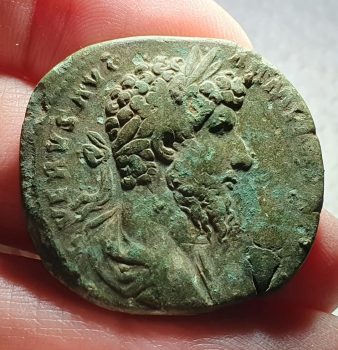Sestertius of Lucivs Vervs
- Date of discovery: 2025-04-13
- Aproximate location of discovery: Zoutleeuw, Vlaanderen
- Context: Fragments of terra sigillata, tegulae, imbrex
This Roman coin is a sestertius, a large bronze denomination widely used during the Roman Empire. Struck between 165 and 166 CE, it features on its obverse (front) a laureate and draped bust of Lucius Verus, facing right. The reverse shows the goddess Victory, towered, winged, and draped, gracefully extending a diadem (a symbol of triumph) toward an unseen recipient. This imagery celebrates martial success and divine favor.
Lucius Verus (130–169 CE) served as co-emperor alongside Marcus Aurelius from 161 to 169 CE. Though often overshadowed by his more famous counterpart, Verus played a central role during the Roman-Parthian War (161–166 CE), a conflict waged in the East that concluded with a Roman victory and the capture of the Parthian capitals of Seleucia and Ctesiphon. The goddess Victory on this coin almost certainly commemorates that military success.
The sestertius (plural sestertii) originated in the Roman Republic but reached its peak usage during the Roman Empire. Made of bronze or orichalcum (a brass-like alloy), it was a large and relatively high-value coin used for everyday transactions and official distributions. Its size and detailed imagery made it an ideal medium for imperial propaganda.
